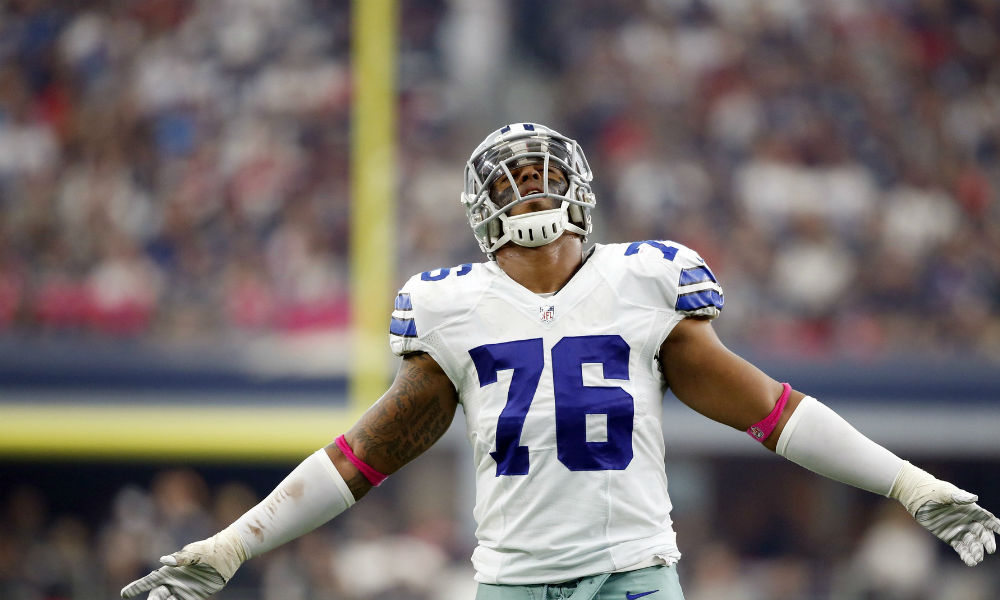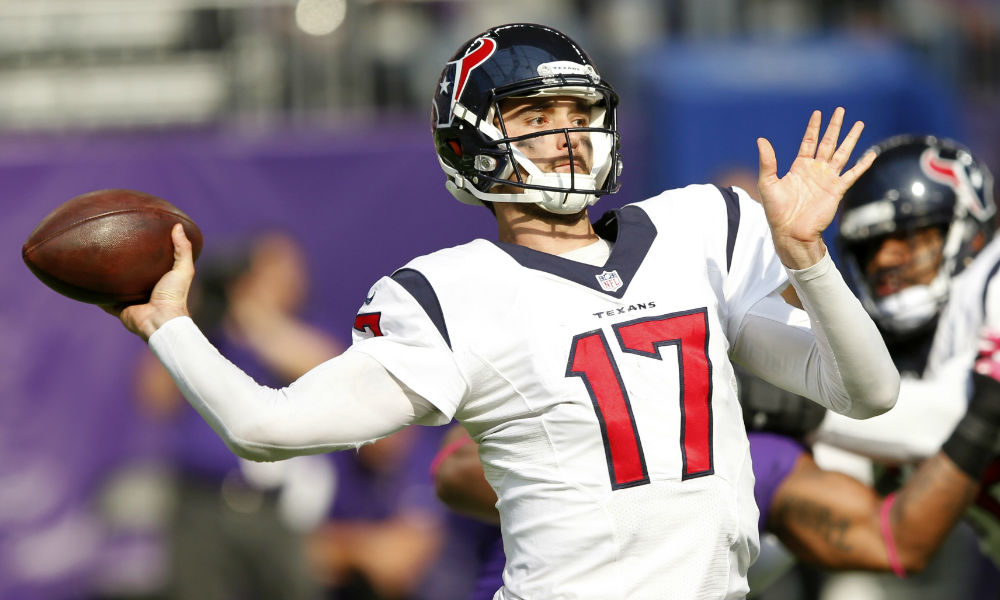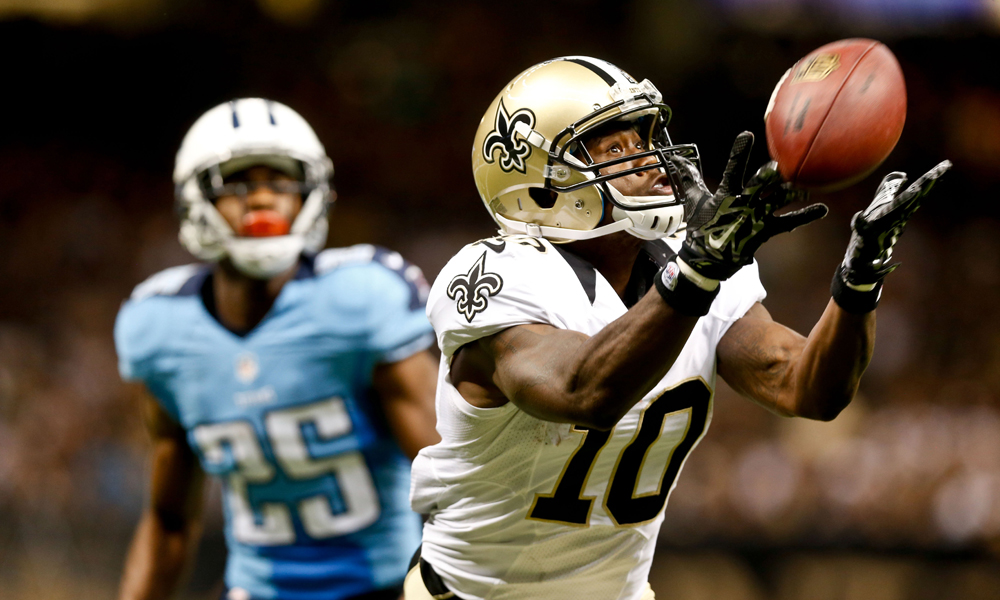News
The Pros and Cons of DeMarco Murray
Cowboys, others must weigh risks of investing long-term in running back.
When NFL free agency officially opens for business on Tuesday afternoon, one of the biggest names hitting the open market will be running back DeMarco Murray, a budding star at one of the most important skill positions on the gridiron.
In his fourth NFL season, at just 26 years old, Murray led the NFL in rushing in 2014, with 1,845 yards on 392 carries, including a league-leading 13 touchdown runs. He was also first in the NFL in yards per game at 115.3, and total yards from scrimmage with 2,261. The 2014 Cowboys centered their offense around Murray and their running game, to take some heat off quarterback Tony Romo. A career year followed at just the right time for Murray to cash in.
His breakout season made Murray a MVP candidate and was a big reason why the Cowboys exceeded expectations, won 12 games and the NFC East title, and came up just a few plays short of the NFC Championship Game.
But the free agent market for Murray is expected to be modest. Several teams entered free agency ready to sign over their remaining salary cap space to anyone who would listen. That led to the best defensive player on the market, star defensive tackle Ndamukong Suh, getting a reported six years and $114 million with $60 million guaranteed from Miami. But the reigning NFL Offensive Player of the Year wasn’t feeling the same love.
A few teams are reportedly interested, including cap-room rich cellar dwellars like the Jacksonville Jaguars and Oakland Raiders, and Dallas is also quite interested in retaining their star running back, at the right price.
That’s where things get tricky as it relates to Murray. What is the right price?
To the untrained eye, Murray appears to have just hit his prime. After two unspectacular seasons while dealing with limited opportunities and injuries in 2011 and 2012, Murray saw his numbers jump in 2013. After he proved to Dallas that he could handle the load, his production grew even more dramatically last season. He also provided elite pass protection for Romo, an underrated factor that adds to his value. Now, entering his age 27 season in 2015, Murray hits the open market with a full skill set and without an overwhelming amount of tread on his tires.
Prior to last season — when the Cowboys ran him ragged, piling up nearly 400 carries and nearly 450 touches — Murray had run the ball just 542 times in three NFL seasons. He also had just 759 carries in four seasons at the University of Oklahoma. And he’s still years away from that magic number age of 30, when running backs supposedly start to decline. So why not invest heavily in this workhorse back, who may still have at least three great years ahead of him?
There are a number of factors at work here that explain why investing a rich, long-term contract in this particular running back would be an unwise decision.
Although Murray’s workload was relatively light leading into the 2014 season, his usage by the Cowboys last season should sound some alarms. Murray’s 392 carries in the 2014 regular season rank seventh all-time and history shows that running backs with an excessive number of carries in one season more often than not tail off in the year or years that follow.
The most recent example is Kansas City’s Larry Johnson, who carried a NFL-record 416 times for the Chiefs during the regular season in 2006 at age 26 (he turned 27 during the season). It was Johnson’s second consecutive season with more than 350 rushes and more than 1,700 yards. But following his record-breaking 2006 season, Johnson played just eight games in 2007 before suffering a foot injury that cost him the rest of the year. He was never the same afterward, totaling just 1,459 yards in 29 games over four seasons before bowing out of the league.
Jamal Anderson is another cautionary tale. At age 26 in 1998, Anderson carried the ball a then league record 410 times for the Falcons, then tacked on 70 more carries during Atlanta’s run to Super Bowl XXXIII. The following year, Anderson tore his right ACL early in a Week 2 game against the Cowboys. He played in all 16 games in his 2000 comeback year, with 282 carries for 1,024 yards. But in the third game of the 2001 season, Anderson tore his other ACL and he retired soon after, at just 29 years of age.
NFL history is littered with stories just like those two. Eddie George saw his production slowly drop off a cliff after his 403-carry 2000 season. After toting the rock 470 times between the regular season and playoffs at age 26 in 1998, Terrell Davis played just 16 more games over the next three seasons before retiring. The list goes on and on. What Aaron Schatz of Football Outsiders wrote way back in 2004, and again in 2007 still holds mostly true:
“A running back with 370 or more carries during the regular season will usually suffer either a major injury or loss of effectiveness the following year, unless he is named Eric Dickerson.”
However, there are actually a few exceptions, not named Eric Dickerson. After his 387-carry season at age 22 in 2000, Edgerrin James tore his ACL six games into the 2001 season, but James went on to play eight more seasons, including five more with over 300 carries and over 1,000 yards rushing. After a 387-carry age 24 season in 2003, Jamal Lewis missed four games the following season, but went on to play in 62 of a possible 64 regular season games in the four years that followed and kept producing up to age 30.
But history shows these cases are rare, and Murray’s durability has already been an issue during his short career. Prior to 2014 — when he played in all 16 of Dallas’ games and their two playoff games despite suffering a broken hand late in the season — Murray had missed 11 of the 48 games played by the Cowboys since they drafted him. In his rookie season, he missed the final three games with a fractured ankle. The next year he missed six games in the middle of the season with a sprained left foot. Then in 2013, he missed two games with a sprained MCL in his knee. Whether his durability in 2014 was a sign of things to come or a fluke remains to be seen.
Age is also a major factor with Murray. Although it’s widely accepted that running backs fall off a cliff at the age of 30, more and more teams are realizing that the decline trend in running backs actually begins around age 27 and 28, a line Murray is already sitting on. As Mike Fisher of Cowboys HQ wrote while separating fact from fiction in regard to Dallas’ chances of retaining Murray, the Cowboys are well aware of this trend:
“Conventional wisdom says NFL running backs fade at 30. But the Cowboys are in possession of a study that shows that “star’’ runners with big production actually fade right after 27. In short: When “standout” runners turn 28, their yards-per-game production goes down 18 percent … at 29, down 30 percent … at 30, down 45 percent … at 31, down 46 percent … at 32, down 55 percent.”
It’s delicate balance that the Cowboys must strike in negotiations, as team vice president Stephen Jones told the media prior to Murray’s breakout 2014 season:
“Running backs have kind of evolved in this league,” Jones said last July. “It’s tough for running backs to have a lot of longevity, but there are ones that do. DeMarco’s a leader and he takes good care of himself. I think his best football is ahead of him.”
Though they’ve continued to praise him publicly entering this offseason, based on their behavior in negotiations, the Cowboys are clearly concerned about Murray’s durability and it’s impact on the return for their potential investment. Cowboys owner Jerry Jones doesn’t often let players he covets get away, and the notion that he hasn’t already worked out a long-term deal to retain Murray says a lot. Dallas probably could have locked the running back up on a much more reasonable deal than they’ll get now prior to the 2014 season, but anyone would have been hard pressed to predict the kind of production and durability Dallas got out of Murray last season.
What they did know going in was that they’d be dedicating their offense to the run in 2014, and as a result they had their most successful season in five years. So the fact that Dallas is still proceeding with caution as it relates to re-signing Murray should breed caution.
The Cowboys realize that much of Murray’s success in 2014 can be attributed to their dominant offensive line. The Cowboys tried having Murray run behind a makeshift line with the likes of Phil Costa, Kyle Kosier, Montrae Holland, Nate Livings and Ryan Cook in 2011 and 2012. The results were solid, but Murray took a lot of contact, which led to the aforementioned injuries.
That’s why Dallas has already stepped up to ink restricted free agent left guard Ronald Leary and unrestricted free agent right tackle Doug Free to keep their 2014 offensive line intact. Those three alongside first round picks left tackle Tyron Smith, center Travis Frederick, and right guard Zack Martin are perhaps more important to Dallas’ success on the ground than a running back.
Jones is also leery of giving a lucrative long-term contract to a running back, after being burned by the seven-year, $45 million pact given to Marion Barber III in 2008, which included $16 million in guaranteed money. Barber was just 25 when he signed that contract, but the Cowboys agreed to it based more on his past production than his future potential.
Barber started declining shortly after signing the new deal and never again produced at the level he had in 2007, when he totaled 975 yards on just 204 carries, an average of 4.8 yards per carry. That production went down to 3.7 YPC in 2008, surged back to 4.4 in 2009, then fell off a cliff to 3.3 YPC in 2010, when he played in just 13 games, carried 113 times and rushed for just 374 yards. The team drafted Murray the following April and cut Barber in July of 2011.
Dallas has learned from their mistake with Barber and they don’t plan to pay Murray for his career season in 2014. Rather they’ll pay him only based on what they think he can produce for them in the next 2-4 seasons. It’s for that reason that the Cowboys have allowed Murray to hit free agency at all, to gage the market.
Stephen Jones told Mark Lane of FOX Sports this week that the team expects Murray to see what’s out there for him and then come back to them, at which point they’ll make the decision whether they want to match the offer.
“There are a lot of things we have to evaluate before we make the ultimate decision as to what our number is going to be with DeMarco versus what some others’ number may be. And at some point, he’ll have to make a business decision, which no one will respect more than us,” Jones said. “He is probably going to get some peace and see what’s out in the market and then we’ll talk and see. I do believe deep down he’d love to stay in Dallas.”
The Cowboys have plenty of palatable, if not perfect, options should Murray gets the big money offer he is seeking, and one that they are unlikely to match. One of the rumored options came off the market Saturday when Mark Ingram signed a four-year, $16 million contract to remain with the New Orleans Saints. But that’s not likely to press Dallas into panic mode.
They drafted Joseph Randle in the fifth round last year and despite his run-ins with the law, Randle showed burst in limited use and could be part of a running back by committee if the Cowboys choose to take that approach. Recently re-signed Ryan Williams, a former first round pick who sat on the team’s practice squad last season, and restricted free agent Lance Dunbar could also factor into the RBBC mix.
Dallas has also had flirtations with Minnesota Vikings running back Adrian Peterson dating back to last offseason, before Peterson got caught up in his own legal trouble, which cost him almost the entire 2014 season. If Murray walks and Peterson is cut loose by Minnesota, Dallas would be at the top of the list of possible destinations for the Texas native. The Cowboys have also been linked to free agent C.J. Spiller recently, and they could even make a play for free agent Ryan Mathews if Murray leaves.
Then there is the draft, which is going to be another strain on the market for Murray. The 2015 draft class is stacked at the running back position, with 6-10 backs that could make an immediate impact expected to be taken in the first two rounds.
There is no doubting that the running back position has lost its luster in recent seasons. Many teams have altered their approach from employing one bellcow back to utilizing several backs in a committee, and front offices have looked to the draft — notably the later rounds therein — to fill their needs cheaply. There is no draft where that has been more of a factor than it will be this year. All of the running back-needy teams, including the Cowboys, will have myriad options in the draft to acquire fresh legs to power their rushing attack.
That’s just another factor working against Murray as teams weigh whether to invest big dollars in their running game by signing him.
One team that was expected to make a run at the league’s reigning rushing champion was the Indianapolis Colts. But according to a report from ESPN’s Mike Wells, Indianapolis isn’t interested. The Colts were initially seen as the biggest threat to Dallas retaining Murray. With nearly $40 million in cap space, they could’ve offered much more money than the Cowboys will be willing to, while giving Murray the same chance to compete for a championship on a dynamic offense, even if the Indianapolis offensive line isn’t on the level of the Dallas front five. Their lack of interest is a good indicator of how dry the market is.
Still, in the wake of the deals given to LeSean McCoy, Marshawn Lynch, Mark Ingram and Frank Gore, Murray can probably expect to end up signing in the range of at least $8 million per year. Jacksonville or Oakland, both loaded with cap space and looking to get above the salary floor, could even swoop in with a $10 million per year offer to seal the deal.
Charles Robinson of Yahoo! Sports tweeted Sunday that the Jaguars are serious about their interest in Murray and could look to do just that. Despite the fact that he’ll be hard pressed to replicate the success in Jacksonville’s offense that he had in Dallas behind that offensive line, Murray would be wise to take his payday, which is likely to be the only one he’ll get in his career.
Reports as the negotiating window opened this weekend indicated that Murray is likely to stay in Dallas if the Cowboys can come close to matching the best offer he receives on the open market. Despite their reluctance to commit too much to this particular asset, due to the litany of factors above, if the offers for Murray stay inside seven figures, the Cowboys are expected to remain in play. It’s worth noting in the days leading up to free agency that Murray was at Duke University on a trip with Dallas coach Jason Garrett, quarterback Tony Romo and tight end Jason Witten. They are a tight knit group and the Cowboys players and front office do highly value what Murray brought to the table for them in 2014.
But if another team pushes all their chips in, I’d advise and expect the Cowboys to fold in this game of Texas Hold ‘Em and let someone else take a risk on the 27-year-old running back.
News
Buccaneers admit mistake, boot Aguayo
Source: Mike Florio of ProFootballTalk
Powered by WPeMatico
News
Did Bucs put too much pressure on Aguayo?
Source: Mike Florio of ProFootballTalk
Powered by WPeMatico
News
Broncos holding their breath on Derek Wolfe
Source: Mike Florio of ProFootballTalk
Powered by WPeMatico




